April Davila's Blog, page 8
June 7, 2023
Make Your Characters Want Something


I am embarrassed to admit that, eight years and countless drafts into writing my first novel, I finally came to truly understand a piece of writing advice I had heard countless times: Make your characters want something.
Seriously, I thought? I’m just learning this, after all this time? But in my own defense, I feel the need to explain that for years I thought I WAS making my main character want something. She wanted to NOT be her mom. Turns out, that’s not enough.
When Characters RefrainWhat I’ve come to understand is that not wanting something actually leaves a vacuum, giving a character little to motivate them. Likewise, it gives the reader nothing to root for, nothing to care about as they embark on the story with that character. There is no story in not wanting something.
Leaning on the lack of something is a tick in my writing that I’ve come to recognize more and more lately, something I am getting better at correcting.
For instance (and I’m just making this up, it’s not actually in my story), say someone pounds on the front door. I used to write something like: nobody moved. While factually accurate, the wording of “nobody moved” leaves a big question mark. What did they do? Did they look at each other? Did they turn pale with fear? Did the room go silent except for the water boiling in a pot on the stove?
See how that lack of something just isn’t very compelling?
When Characters Want SomethingIn the last draft of my novel, I decided to make my main character want something. Specifically, I decided that she wanted to be a forest ranger. And guess what. My first chapters started singing along like never before.
The sentences were la-la-la-ing through those first fifty pages, where they used to lag for *some reason* I couldn’t pin down. It was such a simple shift. I honestly hadn’t thought it would change the story much at all, but it did.
And why a forest ranger? Because that’s who she is. I know her a lot better than I did back when I started writing this story. No doubt that also helped me to finally commit to her desires.
So if you’re struggling with a story, or if your beta readers are telling you it lags a bit in parts, ask yourself – what does your character want? And then choose something. Anything. Maybe your main character is after a high-powered career in finance, or they’re a kid longing for chocolate fudge, or a dog yearning for a bone. Make them want something.
May 31, 2023
Writing Flashbacks
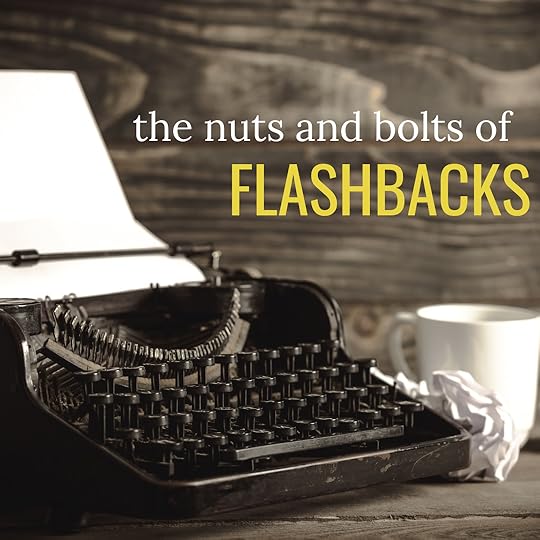

Today we wrap up my little 3-part series on writing flashbacks. In Part 1 we talked about why to use flashbacks (and why not). In Part 2 we talked about the differences between flashbacks and memories. Today I want to talk through some of the nuts and bolts of writing flashbacks well.
How does it relate to the present story?One of the most common ways that flashbacks can go wrong is by failing to relate the flashback to the present story line. This can be logistical or thematic.
Logistically, you need to give the reader a head’s up that a flashback is starting AND let them know when you’re bringing them back to the main storyline. The reader should know when the flashback is taking place in relation to the present story and where it’s happening. If the reader is confused about the timeline or setting, it can make the flashback feel disjointed and confusing.
Likewise, a flashback should be thematically connected to the present story in some way. If the flashback doesn’t have a clear connection to the present, it can feel like a detour and will more than likely confuse the reader.
What words to use?Tense shifts can be a powerful way to signal to the reader that they’re entering a different time frame, but they need to be used carefully to avoid confusing the reader.
There are a few different approaches to tense shifts when writing flashbacks, and each has its own advantages and disadvantages.
Past tense for the flashback: The most common approach to writing flashbacks is to use past tense for the flashback. This can make the flashback feel more distant and less immediate, but it also makes it easier to distinguish between the present moment and the flashback.Present tense for the flashback: Using present tense for the flashbacks creates a sense of immediacy and makes the flashback feel more vivid and immersive. However, it can be jarring for the reader, as it requires a sudden shift in tense and perspective.No tense shift: Some writers choose not to use tense shifts at all and instead rely on other cues (such as changes in scene or dialogue) to signal that the story has shifted to a different time frame. This approach can be effective, but it requires careful attention to detail to avoid confusing the reader.Regardless of which approach you choose, it’s important to be consistent and clear in your use of tense.
If you’re using past tense for both the main story and the flashback, make sure you’re using past perfect (had + past participle) to cue the reader into a flashback, but don’t get crazy. You don’t have to use the past perfect through the whole scene(s). Use it once or twice to cue the reader that a time shift has occurred and then carry on. Otherwise your writing can get really bogged down by all the “he had gone,” and “she had loved.”
May 24, 2023
Flashback vs Memory


This week, for the second installment of my 3-part series on flashback, we’re going to talk a little about how we give our characters backstory. (Click here to read Part 1: Flashbacks: Why Use Them?) The two main tools at our disposal as authors are flashback and memory. Both involve a character revisiting a past event, but there are some key differences between the two, mostly having to do with execution.
TermsBefore we go any further, let’s define our terms.
A memory is a recollection of a past event that a character experiences in the present moment. It is typically triggered by something in the present that reminds the character of the past, such as a smell, sound, or visual cue. Memories are usually brief and fleeting, and they can be used to reveal information about a character’s past or to show how the past is still influencing the present.
On the other hand, a flashback is more extended and immersive. A flashback is typically triggered by something in the present that reminds the character of the past, but instead of a brief memory, the reader is shown the event as if it were happening in real time. Flashbacks can be used to reveal important information about a character’s past, to create tension and suspense, or to add depth and complexity to the story.
Key differencesA key difference between flashbacks and memories is the level of immediacy. A memory is usually experienced by the character in the present moment, whereas a flashback takes the character (and the reader) out of the present and into the past. This can create a shift in the narrative tone and pacing, as well as a shift in the character’s perspective and emotional state.
It’s also worth noting that flashbacks are often more structured than memories. A flashback typically has a beginning, middle, and end, and it follows a clear narrative arc. Memories, on the other hand, can be more free-form and unstructured, and they may not necessarily have a clear narrative arc.
Which to useWhen to use a memory versus a flashback really depends on what you’re trying to achieve in the story. If you just need a quick way to reveal some information about a character’s past, a memory may be sufficient. However, if you want to fully immerse the reader in a past event and show how it’s still influencing the present, a flashback may be more appropriate.
While both memories and flashbacks involve revisiting past events, they differ in terms of their length, immediacy, and narrative structure. Both techniques can be useful in fiction writing, depending on what you’re trying to achieve with your story.
Next week we’ll talk about more of the nuts and bolts of actually writing flashbacks (and memories). Stay tuned…
May 17, 2023
Flashbacks Part 1: Why Use Them?


Flashbacks can be a powerful tool in fiction writing, but they can also be overused and distracting. As a writer, it’s important to understand why to use flashbacks and how to write them effectively. There’s a lot to cover here, so I’m breaking it into three parts. Today we’ll tackle the question of why we should (or shouldn’t) use flashbacks. Next week (and the week after) we’ll tackle the how. Let’s begin!
Reveal backstory and build tensionFlashbacks can be a great way to reveal important information about a character’s past that is relevant to the present-day telling of the story. If a character has a traumatic event in their past that still haunts them, a flashback can be used to show the event and help the reader understand why the character behaves a certain way in the present.
By showing, rather than telling, the reader can experience the event alongside the character and gain a deeper understanding of their motivations.
As writers, we can also use flashbacks to build tension and suspense. By showing a past event that has a connection to the present story, the reader is left wondering how the two events are related and how the character will react when they are forced to confront the past. This can create a sense of anticipation and make the story more engaging for the reader.
Use with cautionWhen flashbacks are overused or not used effectively they can disrupt the flow of the story. If a flashback is too long or comes at an inappropriate time, it can take the reader out of the moment of the story and make it difficult to follow.
What’s more, too many flashbacks can make a story feel disjointed and confusing. If you find yourself writing a ton of flashbacks, ask yourself, does my reader REALLY need to know all of this? Sometimes, as writers, we can get attached to things that don’t absolutely have to be in the story for it to make sense. If you find you actually do have a lot of backstory to cover, consider that you might need to start your story earlier.
When I was writing my first book I was so concerned with getting to the meat of the story that I started the story with a scene that ended up being the middle of the book. No spoilers, but if you’ve read 142 Ostriches, you’ll know what I mean when I refer to the confrontation that happens out in the desert at the midpoint. In early drafts, I opened with that scene, but then I had to write so many flashbacks to explain things that I finally had to acknowledge that I needed to drop into the story earlier in the timeline of my character’s life.
Another issue with flashbacks is that they can be a crutch for weak storytelling. If the only way to make the story interesting is to constantly jump back and forth in time, the story may not be strong enough to stand on its own. If you’re finding that’s the case, I recommend asking yourself what your characters want.
Go forth (by flashing back)It’s important to use flashbacks purposefully and with intention. Before including a flashback, ask yourself if it’s truly necessary for the story and whether it will enhance or detract from the reader’s experience. If it seems important, write it. Even if you end up cutting it later, writing flashbacks is a great way to get to know your characters and understand what motivates them.
May 10, 2023
Dealing With Uncertainty


Writing is a profession that can be incredibly rewarding, but it can also be incredibly uncertain. There are times when it feels like everything is going according to plan, and other times when nothing seems to be going right. As an aspiring writer, it’s important to be able to deal with uncertainty which, I know, is easier said than done. Here are 7 ways I deal. I hope they can help you too.
Know that it’s totally normalUncertainty is a natural part of the creative process, and it’s something that all writers experience. Sometimes we find ourselves writing and we have no idea where the story is going, or if it even is a story. Sometimes ideas fall flat. It’s all part of the job description. Instead of fighting the uncertainty, try to accept it and even appreciate it. Uncertainty can lead to new ideas and new directions.
Have a planWhile uncertainty is a natural part of the creative process, having a plan can help you feel more in control. Before you start writing, take some time to map out your goals and your strategy for achieving them. This can include setting deadlines, creating an outline, or even just making a to-do list. Having a plan in place can help you feel more focused and confident as you work.
Stay focused on the presentWhen you’re dealing with uncertainty, it’s easy to get caught up in worrying about the future. However, this can be counterproductive. Instead of focusing on what might happen, try to stay focused on the present moment. This is the one of the main reasons I integrate mindfulness meditation into my writing practice. If you’re curious to give meditation a try, check out A Very Important Meeting. It’s a great way to dip your toe into mindfulness practice and see if it can help you stay in the present moment.
Practice self-careDealing with uncertainty can be stressful, so it’s important to practice self-care. This can include getting enough sleep, eating well, and taking breaks when you need them. It’s also important to find ways to relax and unwind, such as practicing yoga or meditation, going for a walk, or spending time with friends and family. Taking care of yourself can help you feel more resilient and better able to deal with uncertainty.
Seek supportWriting can be a solitary profession, but that doesn’t mean you have to go it alone. Seek out support from other writers, whether it’s through a writing group, online forum, or social media. Having a community of writers to turn to can be incredibly helpful when you’re feeling uncertain or overwhelmed. They can offer advice, encouragement, and support when you need it most.
Focus on what you can controlWhen you’re dealing with uncertainty, it’s important to focus on what you can control. While you can’t control everything, there are things you can do to increase your chances of success. This might include setting realistic goals, creating a writing schedule, or seeking feedback from others. By focusing on what you can control, you can feel more empowered and better equipped to deal with uncertainty.
Stay positiveFinally, it’s important to stay positive. Writing can be a challenging profession, but it can also be incredibly rewarding. Instead of getting bogged down in negativity, try to focus on the positives. Celebrate your successes, no matter how small they may be, and remind yourself why you love writing in the first place. By staying positive, you can maintain a sense of optimism and hope, even in the face of uncertainty.
Remember that uncertainty is a natural part of the creative process, and that by working through it, you will become a stronger and more successful writer.
May 3, 2023
Check Your Expectations


When we, as writers, set our expectations too high, it can create a sense of pressure and anxiety that can be paralyzing. I have found this to be true on the grand scale as well as in quieter, more nuanced ways (and it’s one of the many things I address in my free webinar on How to Banish Writer’s Block Forever). Let’s start with the grand.
Dream big dreamsWriters have healthy imaginations. It’s kind of our thing. But those imaginations can work against us when we spend our time daydreaming about the masterpieces we’re going to create (instead of doing the work of actually creating it). I will admit to imagining myself sitting across from Oprah, or pacing the dark stage of a TED talk. While it can be (and usually is) fun to play around in these make-believe scenarios, it’s important to check in every now and then to make sure you’re trying to write a novel for the right reasons.
It’s totally fine to want to be rich and famous, but if that’s your ultimate goal, I might humbly suggest that there are easier ways to go about it than writing a novel. In my experience, there is an entire subcategory of people who think they want to write a novel, but really what they want is to have written a (wildly successful) novel. It’s a subtle difference, but a critical one.
Writing a novel takes work. Writing a wildly successful novel takes a lot of work and a fair amount of luck. And again, there’s nothing wrong with imagining your future successes, just don’t let expectations of wealth and fame distract you from actually writing.
Take small actionsEven when we keep our big expectations in check, we can still get tripped up by what we think we should be accomplishing on any given day.
Never (ever) sit down to try and write a novel.
Because how daunting is that? 80,000 words? If it doesn’t sound like a lot, I promise you that after you sit at your desk for a day, laboring over your keyboard, and then check your word count to find you’ve written 623 words – THEN 80,000 starts to feel daunting.
My best advice for avoiding overwhelm (and people laugh when I tell them this): lower your expectations. Seriously. Don’t sit down to write a novel, or even a chapter. Decide to write 500 words, or decide to write for a set amount of time regardless of word count. (A Very Important Meeting is great for this, BTW).
Writing a book, especially a novel or memoir, is a long game. Sometimes you will need to do things that don’t even look like writing, like take a long walk, or read someone else’s book. It’s all part of the job.
The source most expectationsThe pressure of expectations almost always comes from comparing ourselves to others. The one exception would be if you’ve had some success(es) in the past and are worried about living up to those, in which case, you’re comparing yourself to that other person you were when you had those successes.
All you can really do, as a writer, is to write.
Do your best to let all the comparisons go. Set realistic expectations. Instead of aiming for perfection, focus on making progress, and remember that writing is a process. You will rewrite, edit, and rewrite again before you’re done. Give yourself permission to make mistakes. And most importantly, just keep writing.
April 26, 2023
Author Interview: Amy Meyerson


Amy Meyerson’s third book, The Love Scribe, which came out earlier this year, is a charming story about love in all of its many manifestations. It’s Amy’s third book (after The Bookshop of Yesterdays and The Imperfects) and her first to dip into a bit of magic.
Read on to hear some of Amy’s
April: The Love Scribe is different from your first two books in the way that it incorporates magic. What inspired the story?
Amy: You always want a novel to have compelling lore around its origins, but the longer you’re a writer, the less that seems to be the case. For me, anyway. At the start of the pandemic, I was working on a novel with a lot of hands-on research that quickly became impossible. When I talked to my editor about it, she said, Why don’t you write a bookish love story? It took me a moment to wrap my brain around that description, and when I did I was reminded of something my friend had told me about a wedding she’d been to where the bride had hired a poet to write love poems on demand for guests. I was so charmed by that idea, and it got me thinking, what if it wasn’t just a love poem–or in this case a love story–but one that made people fall in love? The rest grew from there. And although this is my first book with fabulist elements in it, I used to write a lot of magical short stories, so it felt like a homecoming to occupy this space.
April: The book is chock-full of romantic stories. Did you borrow any of those from relationships you’ve had/seen in real life, or are they all pulled from your imagination?
Amy: Well, I thought they were pulled from my imagination until my sister-in-law, who just finished it, told me she saw so much of me and people we know on the pages. So…maybe both? Reality slips onto the page in unanticipated ways, and readers who know you will see connections that may or may not be there. I’m sure I did borrow more than I realize. Mostly, I remember calling one of my friends who is divorced from her partner but still together with him to tell her that she’ll see a similar scenario on the page, but it isn’t based on her. And it isn’t. I didn’t realize that it paralleled her story until I finished writing it.
April: Without giving anything away for those who haven’t read it, is there one romantic story in the book that is your favorite?
Amy: In the second half, one love story occupies more space than the earlier ones. It involves Alice’s old teacher, and it’s definitely my favorite.
April: In the time since you published your first book you’ve also created two new humans (who are adorable, btw). Can you talk a little about being a writer while parenting little ones?
Amy: I have to say, I love the way you phrased this as “being a writer while parenting” because so often the question is framed as, how can you write with children? The truth is, there are as many benefits to parenting while writing as there are challenges. I have so many story ideas that I never would have come up with without children. They aren’t in this book, but they are percolating for future books.
Kids are inventive and creative. They force you to be more inventive and creative too. They also say hilarious things. I have a running list on my phone of all the funny things my son says. My daughter doesn’t speak yet, but when she does, there will be a list for her too. And beyond funny things, they make you think about how language is constructed. My son will often parrot our speech patterns, making me realize that I say things like, “I think maybe,” or “It’s interesting because” as preambles to my thoughts. He also gets really confused by “sure,” as in, when I ask him if he’s sure about something he’s just said (like that he doesn’t have to go to the bathroom), he’ll always say, “No, I’m not sure.” I cannot figure out how to explain to him that when he’s certain about something he IS sure. But it makes you realize how nonsensical it is to say that you are sure you don’t want to do something.
Yet, with all the unexpected ways children open up your creativity, they also take over your schedule. For me, that’s the real challenge, securing uninterrupted time to write. Weekends are entirely family time, which is great, but cuts two whole days out of the writing week. I’ve always been someone who likes to write every day, even for an hour, because it keeps the story and the characters fresh in my mind. Both kids do nap on the weekends, but never at the same time. And, when they’ve been at school all week, I don’t want to forfeit my time with them. Then, on weekends or weekdays, I can no longer wake up at 6 if I want to sneak in writing before the day starts because without fail, even if they normally wake up at 7, they trot into the kitchen where I’m writing at 6:15 (or cry from their crib, in my daughter’s case).
I suppose I could write once they’re in bed, but after dinner, my brain is mush. So, there’s physically just not as many optional hours for writing anymore. While that can be stressful, it forces you to spend more time as a writer off the page. In response, I find that I reflect more on the choices I’ve made on the page. That time away helps me come up with solutions when I’m stuck and helps me realize more quickly when something isn’t working. It also helps me get out of the mentality that I always have to be producing, that I need to think about the next project and the one after that and the one after that. Ultimately, that is good for the work, to slow down and be more reflective.
April: What is your writing schedule like? How many hours a day do you devote to your writing? Do you have any little rituals that help you get in the right mindset?
Amy: Ha ha, what schedule? I used to be very diligent about my schedule, pre-children. I would wake up, read for a half-hour or hour over a cup of coffee then get to writing. Depending on whether or not I’m in the semester–I teach at USC–I’ll do one or two writing sessions each day. If I only have time for one, it would come first thing in the morning. Now, first thing in the morning is an hour of making breakfast and lunch and trying to wrangle two children to get them to daycare/preschool.
When I sit down to write, my mind doesn’t have that morning freshness anymore. And something always comes up that pushes my start time later and later. This has made it harder to establish a routine, which I still believe is so important for a writer, but it has taught me how to dive in whenever I have time. So, I’d say I’m a more flexible writer now.
Time permitting, I still like to begin every writing session by reading. Usually this is something unrelated to my current project. Instead, it’s something that is inspiring to me at the moment, something that’s beautiful or compelling in a way that gets me excited about storytelling and the written word.
April: What are you working on now?
Amy: I used to be very open about my work-in-progresses, but I’ve learned that when you tell people what you’re working on, you project your own feelings about the work onto their reaction. If you’re feeling great about it, you’ll see their excitement. Insecure, you’ll see all the ways they (don’t actually) think it’s a terrible idea. This time, I’m trying to keep quiet until I have a solid draft. Also, after THE IMPERFECTS came out, I talked all about a book I didn’t end up writing. People were understandably confused when THE LOVE SCRIBE was a magical, bookish love story instead of a historical mystery about wine.
April: I usually end my author interviews with a lightning round, but since you already answered all my rapid fire questions when we did this last time, I had to come up with a few new ones:
April: Favorite day of the week?
Amy: Thursday. I only teach on Tuesdays on Thursdays, so it gives me that giddy Friday feeling a day early.
April: Do you have any pets?
Amy: Nope, just energetic children.
April: What’s one book you’ve read, but not listed on GoodReads?
Amy: Verity. I wanted to read it to get a sense of why people love Colleen Hoover so much, and I totally get it! She’s a really engaging storyteller. I also read It Ends with Us. But they felt off-brand or maybe like I wasn’t adding anything by saying I read them? Honestly, I can’t remember why I didn’t post them. Maybe I should?
April: What did you have for breakfast this morning?
Amy: We are very into avocado toast these days. My son asks for it “with all the spices” (aka Trader Joe’s everything bagel spice mix), takes four bites, then I eat the rest.
April: What do you wish you’d had for breakfast this morning?
Amy: I’m pretty happy with that breakfast. Maybe an avocado toast without four bites missing?
April: Pratt or Pine?
Amy: Ha ha, can I say neither? I tried to look up another Chris on IMDB, but I guess it’s just not a name for me. If I had to choose, Pine over Pratt for sure.
April: Fuzzy slippers or a gorgeous pair of heels?
Amy: Slippers. Always. In fact, I’m wearing some cozy slippers right now:)
April 19, 2023
Why Kindness Matters
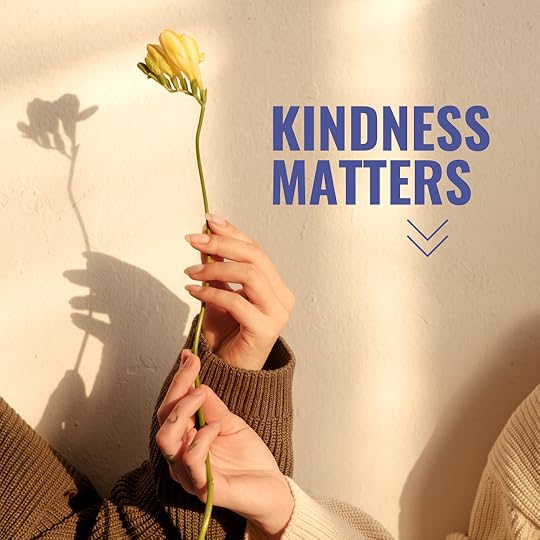
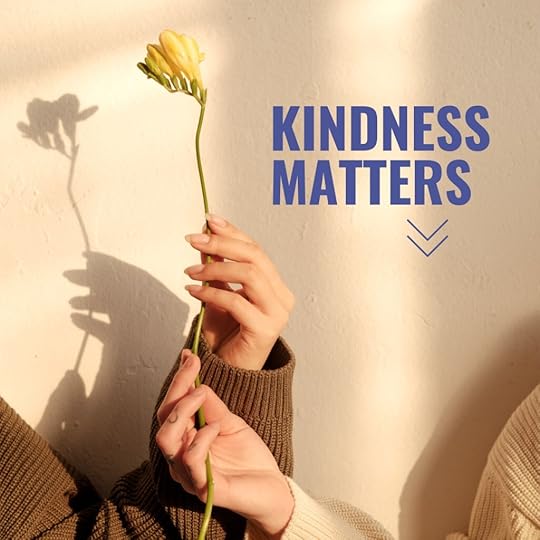
When I tell people that mindfulness forms the basis for how I teach writing I often watch their eyes glaze over. I can almost see what they’re picturing: me with flowers in my hair, sitting in a drum circle, eyes gently closed, swaying from side to side in the sunshine. While that’s lovely (and I’ve got nothing against drum circles), it’s not how I teach writing.
Where Mindfulness Can Go WrongMisconceptions about mindfulness are most prevalent when I talk about the importance of kindness. Somewhere along the way of our human cultural development someone decided that we had to be super effing hard on ourselves if we wanted to be considered “good” and “hardworking.”
Then that misguided, overzealous self-criticism got carried over into mindfulness with disastrous results. Honestly, there are very few ways you can do meditation wrong, but being hard on yourself is #1 on the list.
Imagine you’re meditating. You rest your attention on an anchor and then you realize (because you’re human) that your mind has wondered. Do you think to yourself “oops, got caught up in a thought,” then come back to the anchor and start again, no biggie, or is there a little audio clip that plays in your head that sounds something like “you idiot, you can’t do anything right”?
Pause For a MomentHere’s where kindness matters most. The whole point of mindfulness is to try and see things as they really are, in the present moment.
When your mind wanders, ask yourself, are you really an idiot? Or do minds wander, because that’s what minds do? If you can recognize that your brain is simply doing what millions of years of evolution have trained it to do and meet the moment with kindness, you are seeing the reality of the situation. Which, again, IS THE WHOLE POINT. Then you just let that thought go, come back to your anchor and start again. Kindness moves you closer to reality, while self-flagellation moves your further from it.
If you’re terrible to yourself, you are missing the truth of the present moment, moving deeper into what the Buddhists call delusional thinking, spinning stories where there were none to tell. (As storytellers, we can be particularly good at this.)
Practice KindnessI always tell my students: you get better at the things you practice. If you practice noticing your thoughts with kindness, you will get better at noticing when you’re distracted and this can be a total game changer for your writing. If you beat yourself up, you get better at that – and nobody needs to be better at that.
So be kind with yourself. It’s not just a woo woo, peace and rainbows thing, it’s about being intentional about the way we experience the world.
And if you’d like to know more about how mindfulness can help you with your writing, check out my free guide, Write More, Suffer Less: 4 Ways Mindfulness Can Help You Be a Happier, More Productive Writer.
April 12, 2023
Write Convincing Dialogue
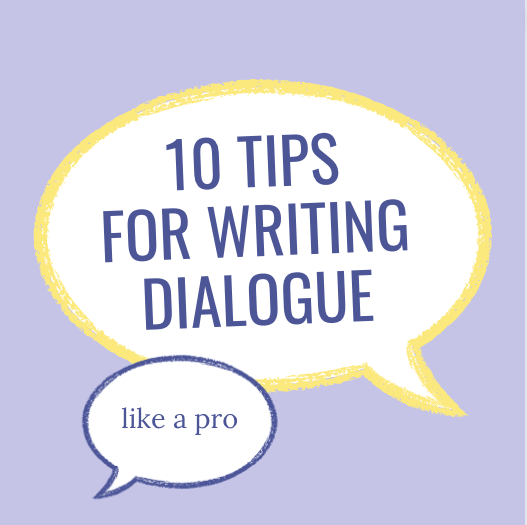
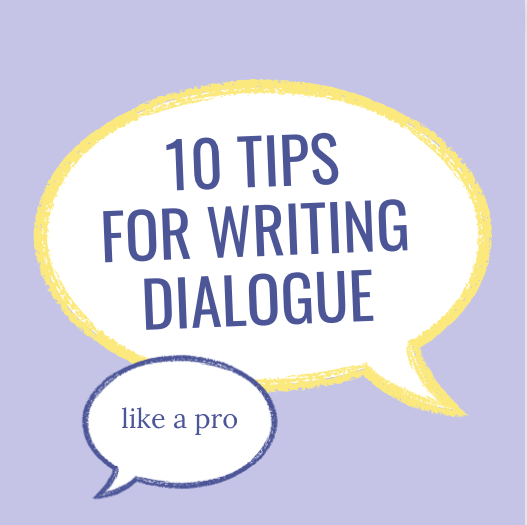
The ability to write convincing dialogue is an essential skill for any fiction writer. Dialogue can make or break a story. It is a crucial element in storytelling that brings characters to life and helps readers connect with them. Good dialogue should not only reveal character traits, but also move the plot forward, build tension, and create an emotional connection between the reader and the characters.
Here are 10 tips on how to write convincing dialogue in fiction:
1. Make it sound naturalDialogue should sound like real, but polished, conversation. It should never be a word-for-word transcript of how people speak in real life with all the ums and repetition. Written dialogue should be a strategically revised version of how people talk, with unnecessary filler words and repetition removed.
One way to make dialogue sound natural is to read it out loud. This helps you identify awkward phrasing, overly formal language, and stilted conversation. It’s also helpful to listen to how people talk in real life, paying attention to sentence structure, slang, and regional expressions.
2. Show, don’t tellGood dialogue should reveal character traits, emotions, and motivations without explicitly stating them. Don’t just tell the reader that a character is angry, let them yell “I can’t believe you did that!” and slam their fist on the table. The reader can infer the character’s anger from their behavior and tone of voice.
3. Use subtextOh, subtext. Subtext is the underlying meaning behind what characters say. It is what they really mean, but do not explicitly state. Subtext can add depth and complexity to dialogue, and create tension between characters.
For example, a character might say “I’m not hungry” when they really mean “I AM hungry, but I’m upset with you and don’t want to eat with you.” The subtext adds depth to the conversation and reveals the character’s true emotions.
4. Use dialogue tags sparinglyDialogue tags are words used to indicate who is speaking. They include “he said,” “she asked,” and “they replied.” While dialogue tags are necessary to avoid confusion, they can become repetitive and distracting if overused.
Instead of using dialogue tags for every line of dialogue, try using action beats to indicate who is speaking. Action beats are actions or descriptions that accompany dialogue, such as “he poured himself a drink” or “she looked out the window.” This not only adds variety to the dialogue but also helps create a mental image of the scene.
5. Use dialect and accents carefullyDialect and accents can add authenticity to dialogue, but they should be used sparingly and carefully. In fact, I would say that unless you are an expert (you grew up speaking with the dialect), tread with extreme caution. Writing convincing dialogue in dialect or with an accent can be difficult to read and can distract from the story.
If you do use dialect or accents, use them consistently and sparingly. A few well-placed words or phrases can convey a character’s background or regional identity without being overwhelming.
6. Embrace silenceNot all dialogue needs to be spoken. Sometimes, silence can be just as effective at conveying emotion and creating tension. Pauses and nonverbal communication can say just as much as words.
For example, a character might pause before responding to a question, indicating they are considering their answer. Another character might fidget or avoid eye contact, indicating discomfort or guilt.
7. Avoid expositionExposition is information that is necessary for the reader to understand the story but is not conveyed through action or dialogue. It can be tempting to use dialogue to convey exposition, but this can come across as clunky and artificial. Do a word search for the phrase “as you know.” It it comes up in dialogue, you should cut that line and find some other way to get the information across.
Instead of having characters explain things to each other, try to convey information through action or description. For example, instead of having a character explain their entire backstory in a conversation, have them look at a photograph or visit a place from their past.
8. Vary sentence structure and lengthGood dialogue should be varied in its sentence structure and length. Monotonous dialogue can quickly become boring and predictable. Using a variety of sentence lengths and structures can add rhythm and flow to the conversation.
Short sentences can create tension and indicate urgency, while longer sentences can convey a character’s thoughtfulness or uncertainty. Varying the structure of the dialogue can also help create a unique voice for each character.
9. Use contractionsThis one seems like it would go without saying, but I’m actually surprised how often I see clunky, word for word dialogue in early drafts. You should absolutely use “can’t” instead of “cannot” or “it’s” instead of “it is.” Using contractions in dialogue can make it sound more natural and help create a conversational tone.
However, it is important to use contractions appropriately. Not all characters would use them, such as those who speak in a more formal or archaic style. Similarly, it may not be appropriate for a character who is angry or upset.
10. Stay true to the characterEvery character should have a distinct voice and way of speaking. Dialogue should be consistent with a character’s personality, background, and motivation. A character’s dialogue might also change over time as they experience character development.
For example, a character who is shy and introverted at the beginning of the story may become more confident and assertive as they grow. Their dialogue should reflect this change in their personality.
Keep it realWriting convincing dialogue in fiction is a skill that takes practice and attention to detail. Dialogue should sound natural, show rather than tell, use subtext, and avoid exposition. Dialogue tags and accents should be used sparingly, and sentence structure and length should be varied. Above all, dialogue should be consistent with the character’s personality and motivation.
Do you have any tricks that you use for dialogue in your stories? If so, drop them below. I always love to hear how other folks navigate these tricky waters.
April 5, 2023
Author Interview: Charlotte Maya
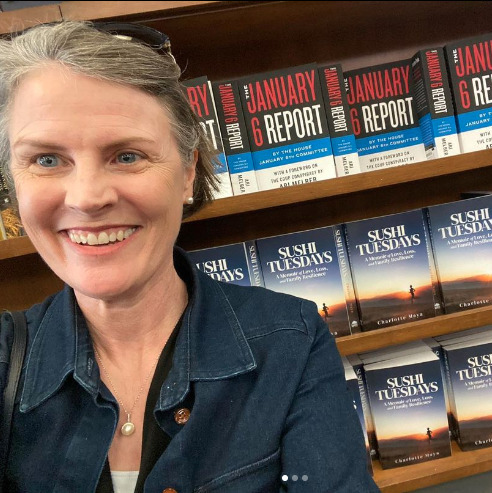
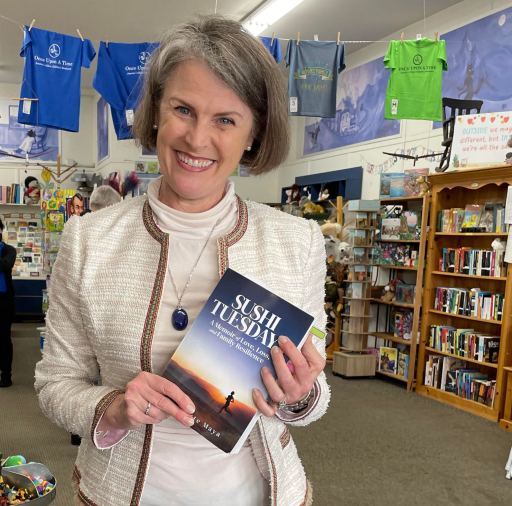
Charlotte Maya’s memoir, Sushi Tuesdays, came out in February. It’s about her husband’s suicide, and I will admit to being a little daunted by the subject matter when I first heard about it. Nobody likes to think about such devastating loss, but Charlotte’s writing so beautifully captures her voice (in all its compassion, humor, and optimism), that I was drawn in.
I asked her to do an interview for the blog because, as she is quick to point out, suicide is the second leading cause of death for people ages 25-34 and we, as a society, don’t talk about it. Her book is an incredible start to the conversation. I hope you enjoy my interview with Charlotte Maya. I highly recommend you buy the book and follow her on Instagram.
April: When you first started writing about your husband’s suicide you did so on a blog. When did you decide you wanted it to be more than a blog, that you wanted to write a memoir?
Charlotte: Initially, I wanted to write a memoir, but that felt too daunting. A full length memoir is 75,000–100,000 words, and a blog post is more like 1,000 words. So I started a blog. (Not to mention, by then I had remarried, we had blended into a family with four children, two cats, and two dogs.)
At first, I was afraid that the subject of suicide might leave me chattering to myself, but instead I found community. I was encouraged by the fact that readers wanted to know what I had to say about suicide loss, mental health, grief, healing, and hope.
Suicide is the 10th leading cause of death in this country (2nd for the age group 25–34), but as a culture, we don’t talk about it. When I started writing openly about suicide, I found that people were aching to have this conversation, so I knew there would be an audience for the book. I just wasn’t quite sure how to write it.
April: And what was the process you went through? What worked and what didn’t?
Charlotte: After several years of posting blogs every Tuesday, I certainly had the word count, but those didn’t tell a cohesive story. When I printed out the blog posts and put them in the semblance of an order, I had some scenes and exposition but no coherent narrative with a beginning a middle and end.
I hired a book coach who taught me about structure, plot, and character development. She helped me put together an outline for the book, which was about 100 pages single-spaced. It was a robust outline, so I kind of thought the book would write itself. It didn’t.
My first draft took forever to write and about that long to read. I gave up on the idea, but then the story kept dragging me back in, if that makes sense. Suicide is a story demanding to be told because talking about it is what helps. Silence doesn’t. Honesty and transparency reduce the stigma, the shame, and the isolation. Draft two went back to the book coach and was returned to me looking like a Los Angeles traffic map on a summer night with the Dodgers playing at home and a sold out Hollywood Bowl. I gave up again.
The particular challenge of memoir is crafting a story out of my life. In life, everyone is precious to me; everything that happened is important. And yet, they do not all necessarily belong in the story. So, I kept working until, by draft four, I had a manuscript I felt comfortable sharing with a few early readers. With their feedback, I revised the manuscript another time, and draft five is pretty close to the published book.
April: One of the things I really admired about your book was how, despite dealing with a difficult topic, you captured a wonderful sense of optimism. How intentional was this? Were there sections that you had to rewrite to make them more positive?
Charlotte: Great question. I think I’m a pretty optimistic person (with a dark sense of humor). After Sam died, I didn’t want to become embittered. It makes sense that my writing would reflect that desire — not to ignore the devastation — but to hold both the trauma and a sense of forward movement.
By the time I was up to my elbows in writing the manuscript, my life was stable and happy (as much as a brood of kids and a small menagerie allow), so it was more work to dive deeper back into those despairing days.
April: Now that the book is out in the world, you are having a lot of discussions about suicide. What is the most prevalent misconception you’ve encountered about suicide?
I think people need to understand that suicide is a disease. Suicide is an illness, just like diabetes or cancer or heart disease. Every part of our human physiology is designed for self-preservation, so when there is a neurological or chemical or emotional imbalance, that’s not normal or healthy. That’s when we need to seek help. Mental health IS health.
Also, the language we use to talk about suicide makes a difference. We no longer say “committed suicide” because of its criminal connotations. Suicide is not a crime; it’s not a “choice.” It is, however, a complicated death and one that is particularly difficult to heal from. The stigma and shame threaten to reduce our loved one’s lives to their last moments, which is unfair and inaccurate. And when we are open to these conversations, we can honor the whole person.
I draw a great deal of hope from the 988 National Lifeline (call or text 24/7). The fact that we have this Lifeline normalizes mental health struggles and reminds all of us that help is available and that we are not alone.
If you or someone you know is struggling, don’t wait. Reach out:
NAMI https://nami.org/Home
AFSP https://afsp.org/
April: What was the hardest part of the story to write?
Charlotte: It’s always hard to think about how much the children have suffered. I still wish I could spare them. There’s no expiration date on grief. There will always be days when Sam’s suicide crushes us, like graduations and weddings and birthdays.
It was also challenging to write my husband Tim. He is hilarious in real life, and by the time I had written several sentences describing his antics, his throwaway lines, his spot-on imitations, his encyclopedic memory for songs, and his facial expression, he didn’t seem nearly as funny. I took to jotting down notes every time he made me laugh until I felt I could capture him on the page, which is not unlike setting a leprechaun trap.
April: What was the easiest?
Charlotte: Ironically, some of the early scenes after Sam’s suicide. Those initial moments of trauma and early days are indelibly devastating, so it’s not hard to transport myself back into those moments. By the time I was writing the memoir, I had answered so many questions about those moments and written so much about them that (and had so much therapy), I could go back there without being emotionally overwhelmed and just write.
And I always like to end with a lightning round of silly questions, just to get to know you a little better.
April: Coffee or Tea?
Charlotte: YES, please. Dark and caffeinated with a splash of oat milk all morning. Transition to green or white tea after noon. Herbal tea in the evening.
April: Whiskey or Vodka?
Charlotte: Champagne
April: Hemsworth or Gosling?
Charlotte: Who? Sigh. I need to get out of my books and into a theater, or at least turn on something streaming.
April: “Sneaked” or “snuck”?
Charlotte: Snuck
April: Wetsuit or bathrobe?
Charlotte: I feel gritty and sunburned just thinking about a wetsuit. Bathrobe.



